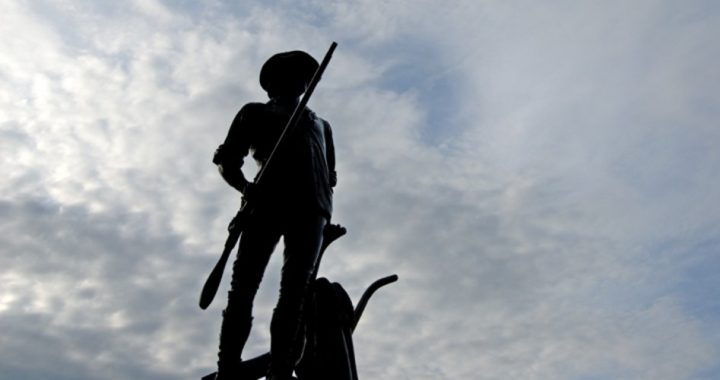
April 19 is a pivotal date in U.S. history. Long known as “Patriot’s Day,” it is celebrated on the third Monday of April in Massachusetts and Maine, in remembrance of when “the embattled farmers stood, and fired the shot heard ’round the world.” The Boston Marathon is even scheduled to coincide with Patriot’s Day.
In addition to marking the opening of the American War for Independence at the Battles of Lexington and Concord, the day is also now remembered for two other events in our nation’s history, although without the glory usually associated with the patriotism of April 19, 1775.
It was on April 19, 1993, when the FBI launched its final assault on the Branch Davidian compound outside Waco, Texas, leading to the deaths of scores of members of that religious group, including children, in a blazing inferno. Then, in an apparent act of revenge, Branch Davidian avenger Timothy McVeigh (and “others unknown,” in the words of the federal grand jury that indicted him) blew up the Murrah Federal Building in downtown Oklahoma City, Oklahoma on April 19, 1995, killing nearly two hundred Americans, including many children, simply going about their daily activities.
Following the Boston Tea Party, on December 16, 1773, when members of the Sons of Liberty dumped over 300 chests of tea into Boston Harbor, the British Parliament passed a series of laws known in the colonies as the “Intolerable Acts,” one of which placed Massachusetts under a military dictatorship, led by General Thomas Gage. Gage directed a house-to-house search for firearms, confiscating hundreds of guns.
Then, Gage’s spies heard of the stockpiling of weapons by opponents of British rule (“patriots”) in Concord, about 20 miles outside Boston. Determined to “nip the rebellion in the bud,” Gage sent British redcoats to seize the guns. As all tyrants throughout history have understood, it is much easier to impose dictatorial rule if the general population has no access to weapons.
Paul Revere and other patriots, however, alerted the townsfolk in the area outside Boston that British forces were on their way, and the militia at Lexington (located on the road to Concord) stood in the Village Green to protest the British violation of their liberties. It was here that the first shots of the American Revolution were fired (all with unregistered guns); however, that volley of shots did not deter the British advance toward Concord.
Once the British arrived in Concord, however, the patriots were better armed and prepared, meeting the redcoats at Old North Bridge, inflicting 73 casualties upon His Majesty’s forces. Because of a poem written years after the event by Ralph Waldo Emerson, Concord has been able to claim that “the shot heard ‘round the world” was first fired here, rather than at Lexington. (If you visit Lexington, they will make clear the “real” history.)
But whichever site was first, the war was on — which would eventually lead America to secede from the British Empire.
It was coincidence that the tragic episode outside Waco, Texas occurred on April 19, 1993. On February 28, the Bureau of Alcohol, Tobacco, and Firearms (ATF) staged a dawn raid on a religious compound, charging that the Davidians were stockpiling illegal weapons, abusing children, and manufacturing illegal drugs. None of these charges was ever actually proved. The Davidians fought back, leading to a stand-off until April 19. After the initial raid failed, with four agents and six Davidians killed, the ATF had given way to the FBI.
On April 19, the FBI, using tanks, began a final assault upon the Davidian compound, after the use of CS gas (banned under international agreements for use in warfare) failed to make the Davidians leave their home and surrender.
The surviving Davidians claim that it was a combination of the tanks pounding on the walls of their building, knocking over lanterns in a space filled with propane fuel (the government had cut off their electricity earlier) and CS gas that started the fires which killed most of those inside. The government, on the other hand, contends that it was Davidian leader David Koresh who ordered the fire started — either in self defense, to kill FBI agents, or in an act of mass suicide. President Bill Clinton even callously asserted, “A bunch of religious fanatics murdered themselves.”
Regardless of who was telling the truth, the tragic episode at Waco led Timothy McVeigh and “others unknown” to plot an act of “revenge” against the U.S. government. Why McVeigh chose the Murrah Building in Oklahoma City is a matter of speculation, but it did include offices of the ATF.
Ominously, it also included a daycare, with children, of which McVeigh was allegedly aware. Some speculate that McVeigh specifically targeted these children as part of his “revenge” for the deaths of children at the Davidian compound two years earlier.
We do know that McVeigh deliberately chose the date of April 19 to coincide with the second anniversary of the deaths at Waco.
Because of this, April 19 is a date forever etched into the collective consciousness of Americans: the glorious day the “embattled farmers” stood up to British tyranny in 1775, and two of the saddest days in U.S. history: the Waco tragedy and the bombing of the Murrah Building.
Photo: EyeJoy/iStock/Getty Images Plus



